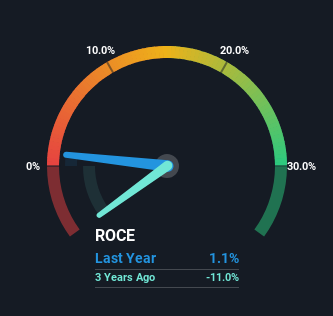- India
- /
- Infrastructure
- /
- NSEI:DREDGECORP
These Return Metrics Don't Make Dredging Corporation of India (NSE:DREDGECORP) Look Too Strong

When it comes to investing, there are some useful financial metrics that can warn us when a business is potentially in trouble. A business that's potentially in decline often shows two trends, a return on capital employed (ROCE) that's declining, and a base of capital employed that's also declining. This combination can tell you that not only is the company investing less, it's earning less on what it does invest. In light of that, from a first glance at Dredging Corporation of India (NSE:DREDGECORP), we've spotted some signs that it could be struggling, so let's investigate.
Understanding Return On Capital Employed (ROCE)
For those who don't know, ROCE is a measure of a company's yearly pre-tax profit (its return), relative to the capital employed in the business. The formula for this calculation on Dredging Corporation of India is:
Return on Capital Employed = Earnings Before Interest and Tax (EBIT) ÷ (Total Assets - Current Liabilities)
0.011 = ₹170m ÷ (₹24b - ₹8.0b) (Based on the trailing twelve months to June 2024).
Therefore, Dredging Corporation of India has an ROCE of 1.1%. In absolute terms, that's a low return and it also under-performs the Infrastructure industry average of 13%.
See our latest analysis for Dredging Corporation of India

While the past is not representative of the future, it can be helpful to know how a company has performed historically, which is why we have this chart above. If you'd like to look at how Dredging Corporation of India has performed in the past in other metrics, you can view this free graph of Dredging Corporation of India's past earnings, revenue and cash flow.
So How Is Dredging Corporation of India's ROCE Trending?
The trend of ROCE at Dredging Corporation of India is showing some signs of weakness. The company used to generate 2.6% on its capital five years ago but it has since fallen noticeably. What's equally concerning is that the amount of capital deployed in the business has shrunk by 24% over that same period. When you see both ROCE and capital employed diminishing, it can often be a sign of a mature and shrinking business that might be in structural decline. Typically businesses that exhibit these characteristics aren't the ones that tend to multiply over the long term, because statistically speaking, they've already gone through the growth phase of their life cycle.
While on the subject, we noticed that the ratio of current liabilities to total assets has risen to 33%, which has impacted the ROCE. If current liabilities hadn't increased as much as they did, the ROCE could actually be even lower. While the ratio isn't currently too high, it's worth keeping an eye on this because if it gets particularly high, the business could then face some new elements of risk.
Our Take On Dredging Corporation of India's ROCE
In short, lower returns and decreasing amounts capital employed in the business doesn't fill us with confidence. Since the stock has skyrocketed 158% over the last five years, it looks like investors have high expectations of the stock. Regardless, we don't feel too comfortable with the fundamentals so we'd be steering clear of this stock for now.
If you want to continue researching Dredging Corporation of India, you might be interested to know about the 2 warning signs that our analysis has discovered.
For those who like to invest in solid companies, check out this free list of companies with solid balance sheets and high returns on equity.
New: Manage All Your Stock Portfolios in One Place
We've created the ultimate portfolio companion for stock investors, and it's free.
• Connect an unlimited number of Portfolios and see your total in one currency
• Be alerted to new Warning Signs or Risks via email or mobile
• Track the Fair Value of your stocks
Have feedback on this article? Concerned about the content? Get in touch with us directly. Alternatively, email editorial-team (at) simplywallst.com.
This article by Simply Wall St is general in nature. We provide commentary based on historical data and analyst forecasts only using an unbiased methodology and our articles are not intended to be financial advice. It does not constitute a recommendation to buy or sell any stock, and does not take account of your objectives, or your financial situation. We aim to bring you long-term focused analysis driven by fundamental data. Note that our analysis may not factor in the latest price-sensitive company announcements or qualitative material. Simply Wall St has no position in any stocks mentioned.
About NSEI:DREDGECORP
Dredging Corporation of India
Provides dredging services to various ports, the Indian navy, fishing harbors, and other maritime organizations primarily in India.
Imperfect balance sheet very low.

